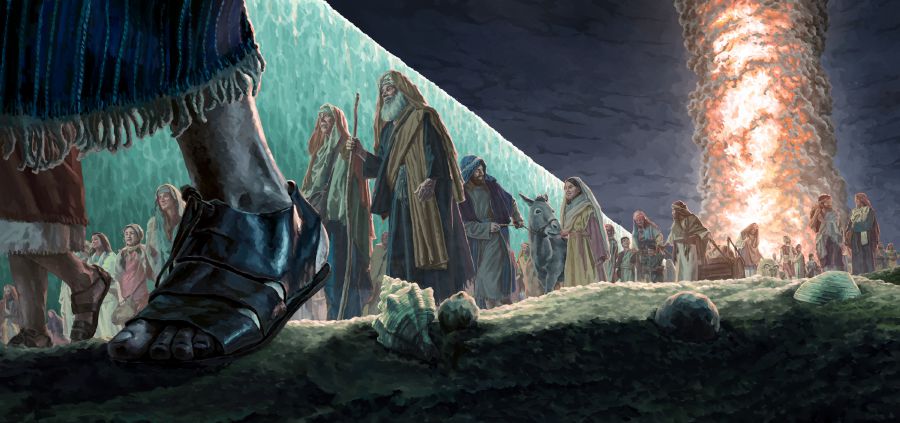This article is part of a series on Old Testament Christophanies. For important background information, see An Introduction to Old Testament Christophanies–with Justin Martyr.

As the Israelites were heading toward the Red Sea, the Lord made it clear that His promise to lead them out of Egypt wasn’t limited to Him guiding them from Heaven:
The LORD was going before them in a pillar of cloud by day to lead them on the way, and in a pillar of fire by night to give them light, that they might travel by day and by night. He did not take away the pillar of cloud by day, nor the pillar of fire by night, from before the people (Exod 13:21–22).
Yahweh Himself was in the pillar and He would later speak from it on several occasions (e.g., Num 12:5–8; Deut 31:15–21; Ps 99:6–7). The pillar, a powerful reminder of God’s presence, remained with the people until they reached the Promised Land. After they had arrived, the Angel of the Lord told the sons of Israel that it was He who had brought them out of Egypt and into the land He swore to their fathers (Judg 2:1).
The Targum says that “the glory of the Shekinah of the Lord” went before the people.[1] The pillar of cloud and the pillar of fire were the same thing: the glory of the Lord. The cloud or smoke produced by the fire was easier to see during the day, while the glory’s fire was more apparent at night. Think of the pillar as a Shekinah tornado—and in the eye walked the Son of God before the Israelites.
Just before the Lord divided the Red Sea, “the angel of God” changed positions: from going before the Israelites to behind their camp. The pillar also moved between them and the Egyptians. It created a cloud and darkness between the two camps, though it gave light at night. This kept the two camps separated all night (Exod 14:19–20). “Yahweh,” as depicted leading the Israelites in Exodus 13:21, becomes “the angel of God” here, meaning that this angel is the Angel of the Lord. The Targums agree that this was the Angel of the Lord.[2] He had been leading the Israelites from the front, but now moved behind them to create, as it were, a wall out of His glory. The Angel went from being a guide to a guard. The account suggests that the pillar provided light to the Israelites, but to the Egyptians it was only darkness. The Son protected and provided for His people, while at the same time blinding those who sought their lives.
Moses stretched his hand over the sea and the Lord divided the waters. As the Israelites were walking through the midst of the sea on dry land, the waters to their right and left were like walls. The Egyptians, including all of Pharaoh’s horses, chariots, and horsemen, entered the passageway in pursuit (Exod 14:21–23). Soon after, the Lord took notice:
At the morning watch, the LORD looked down on the army of the Egyptians through the pillar of fire and cloud and brought the army of the Egyptians into confusion. He caused their chariot wheels to swerve, and He made them drive with difficulty; so the Egyptians said, “Let us flee from Israel, for the LORD is fighting for them against the Egyptians” (Exod 14:24–25).
From within the pillar, Yahweh looked down on the Egyptians. One of the Targums says that it was “the Word of the Lord” that looked upon them.[3] As He confounded their movements, the Egyptians were forced to recognize that it was Yahweh who fought against them.
The Lord ordered Moses to stretch forth his hand again. As he did, the waters rushed back to fill the passageway, covering every Egyptian. Meanwhile, the Israelites were able to safely cross the sea (Exod 14:26–29). Now the people were in a far better position to appreciate the saving power of the Lord:
Thus the LORD saved Israel that day from the hand of the Egyptians, and Israel saw the Egyptians dead on the seashore. When Israel saw the great power which the LORD had used against the Egyptians, the people feared the LORD, and they believed in the LORD and in His servant Moses (Exod 14:30–31).
In verse 31, Targum Onkelos replaced “believed in the LORD” with “believed in the Word of the Lord.”[4] Targum Pseudo-Jonathan says that the people “believed in the Name of the Word of the Lord.”[5] It is doubtful that the author of this Targum would have written such a strong statement of faith in reference to the Word if he didn’t think that the Word was God.
The Word of the Lord, His memra, is the name of a divine person. In John 1:12, the apostle taught that the Word, Jesus Christ, gave the right to become children of God to those who believe in His name. Jesus stated, “he who does not believe has been judged already, because he has not believed in the name of the only begotten Son of God” (John 3:18b). The phrase “believe in His name” (including variations of it) is used several times in the New Testament to refer to Jesus Christ, the Son of God; not a single use in the Bible refers to a created being. It means to trust in who and what He is. The Word of the Lord was a Savior to His people during the Exodus. He is a Savior to those now who place their full trust in Him.
[1] Targum Pseudo-Jonathan on Exodus 13:21.
[2] Targum Onkelos and Targum Pseudo-Jonathan on Exodus 14:19.
[3] The Jerusalem Targum on Exodus 14:24.
[4] Targum Onkelos on Exodus 14:31.
[5] Targum Pseudo-Jonathan on Exodus 14:31.

Leave a Reply